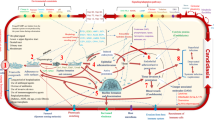Abstract
Cryptococcus neoformans is an encapsulated yeast-like fungus that is a relatively frequent cause of meningoencephalitis in immunocompromised patients and also occasionally causes disease in apparently healthy individuals. This fungus collectively forms biofilms on polystyrene plates and medical devices, whereas individually can undergo phenotypic switching. Both events have profound consequences in the establishment of fungal infection and are associated with persistent infection due to increase resistance to antimicrobial therapy. In this study, we characterized switch phenotypes in C. neoformans biofilms. Smooth, mucoid, and wrinkled switch phenotypes of various switching C. neoformans strains were examined for their adhering and biofilm-forming ability on 96-well plates using cell counts and 2,3-bis (2-methoxy-4-nitro-5-sulfophenyl)-5-[(phenylamino) carbonyl]-2H-tetrazolium hydroxide (XTT) reduction assay, respectively. Both assays showed that C. neoformans strains with the parent smooth phenotype adhered and formed stronger biofilms than their mucoid and wrinkled counterparts. Furthermore, the phenotypic switching frequencies of the individual colony types grown in biofilms or as planktonic cells were investigated. For the parent smooth variant of most strains, we found enhanced phenotypic switching in cryptococcal biofilms when compared to switching rates of planktonic cells. In contrast, the back-switching rate of mucoid to smooth variant was significantly higher in planktonic cells of seven strains of C. neoformans strains. These results suggested that phenotypic switching can occur in cryptococcal biofilms and extend our understanding of the relationship of both phenomena.


Similar content being viewed by others
References
Mitchell TG, Perfect JR. Cryptococcosis in the era of AIDS—100 years after the discovery of Cryptococcus neoformans. Clin Microbiol Rev. 1995;8:515–48.
Vecchiarelli A. Immunoregulation by capsular components of Cryptococcus neoformans. Med Mycol. 2000;38:407–17. doi:10.1080/714030973.
Levitz SM. The ecology of Cryptococcus neoformans and the epidemiology of cryptococcosis. Rev Infect Dis. 1991;13:1163–69.
Goldman D, Fries B, Franzot S, Montella L, Casadevall A. Phenotypic switching in the human pathogenic fungus Cryptococcus neoformans is associated with changes in virulence and pulmonary inflammatory response in rodents. Proc Natl Acad Sci USA. 1998;95:14967–72. doi:10.1073/pnas.95.25.14967.
Guerrero A, Jain N, Goldman DL, Fries BC. Phenotypic switching in Cryptococcus neoformans. Microbiology. 2006;152:3–9. doi:10.1099/mic.0.28451-0.
Fries BC, Cook E, Wang X, Casadevall A. Effects of antifungal interventions on the outcome of experimental infections with phenotypic switch variants of Cryptococcus neoformans. Antimicrob Agents Chemother. 2005;49:350–7. doi:10.1128/AAC.49.1.350-357.2005.
Dromer F, Mathoulin-Pélissier S, Launay O, Lortholary O, The French Cryptococcosis Study Group. Determinants of disease presentation and outcome during cryptococcosis: The Crypto A/D Study. PLoS Medicine. 2007;4(2):e21. doi:10.1371/journal.pmed.0040021.
Martinez LR, Casadevall A. Cryptococcus neoformans cells in biofilms are less susceptible than planktonic cells to antimicrobial molecules produced by the innate immune system. Infect Immun. 2006;74:6118–23. doi:10.1128/IAI.00995-06.
Martinez LR, Casadevall A. Susceptibility of Cryptococcus neoformans biofilms to antifungal agents in vitro. Antimicrob Agents Chemother. 2006;50:1021–33. doi:10.1128/AAC.50.3.1021-1033.2006.
Martinez LR, Casadevall A. Specific antibody can prevent fungal biofilm formation and this effect correlates with protective efficacy. Infect Immun. 2005;73:6350–62. doi:10.1128/IAI.73.10.6350-6362.2005.
Walsh TJ, Schlegel R, Moody MM, Costerton JW, Salcman M. Ventriculoatrial shunt infection due to Cryptococcus neoformans: an ultrastructural and quantitative microbiological study. Neurosurgery. 1986;18:373–5. doi:10.1097/00006123-198603000-00025.
Franzot SP, Mukherjee J, Cherniak R, Chen L, Hamdan JS, Casadevall A. Microevolution of a standard strain of Cryptococcus neoformans resulting in differences in virulence and other phenotypes. Infect Immun. 1998;66:89–97.
Meshulam T, Levitz SM, Christin L, Diamond RD. A simplified new assay for assessment of fungal cell damage with the tetrazolium dye, (2,3)-bis-(2-methoxy-4-nitro-5-sulphenyl)-(2H)-tetrazolium-5-carboxanilide (XTT). J Infect Dis. 1995;172:1153–6.
Fries BC, Taborda CP, Serfass E, Casadevall A. Phenotypic switching of Cryptococcus neoformans occurs in vivo and influences the outcome of infection. J Clin Invest. 2001;108:1639–48.
McFadden DC, Fries BC, Wang F, Casadevall A. Capsule structural heterogeneity and antigenic variation in Cryptococcus neoformans. Eukaryot Cell. 2007;6:1464–73. doi:10.1128/EC.00162-07.
Jin Y, Samaranayake YH, Yip HK, Samaranayake LP. Characterization of switch phenotypes in Candida albicans biofilms. Mycopathologia. 2005;160:191–200. doi:10.1007/s11046-005-6331-x.
Fries BC, Goldman DL, Cherniak R, Ju R, Casadevall A. Phenotypic switching in Cryptococcus neoformans results in changes in cellular morphology and glucuronoxylomannan structure. Infect Immun. 1999;67:6076–83.
Laffey SF, Butler G. Phenotype switching affects biofilm formation by Candida parapsilosis. Microbiology. 2005;151:1073–81. doi:10.1099/mic.0.27739-0.
Nivens DE, Ohman DE, Williams J, Franklin MJ. Role of alginate and its O acetylation in formation of Pseudomonas aeruginosa microcolonies and biofilms. J Bacteriol. 2001;183:1047–57. doi:10.1128/JB.183.3.1047-1057.2001.
Acknowledgment
This work was supported by RO1 AI059681-04 grant and the Einstein’s Hispanic Center of Excellence (HCOE).
Author information
Authors and Affiliations
Corresponding author
Rights and permissions
About this article
Cite this article
Martinez, L.R., Ibom, D.C., Casadevall, A. et al. Characterization of Phenotypic Switching in Cryptococcus neoformans Biofilms. Mycopathologia 166, 175–180 (2008). https://doi.org/10.1007/s11046-008-9133-0
Received:
Accepted:
Published:
Issue Date:
DOI: https://doi.org/10.1007/s11046-008-9133-0




